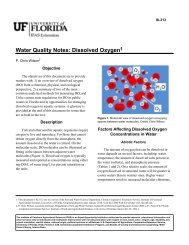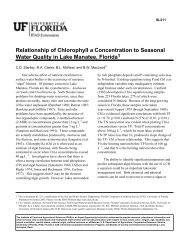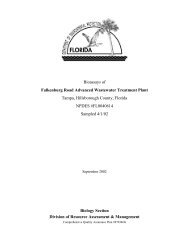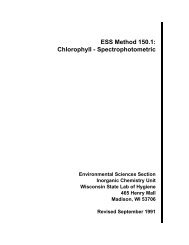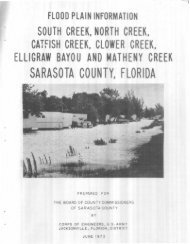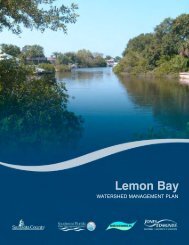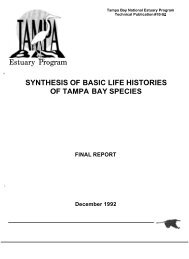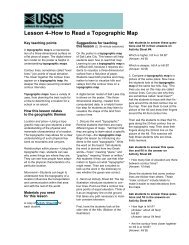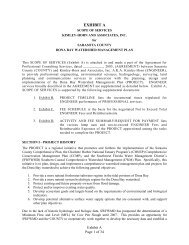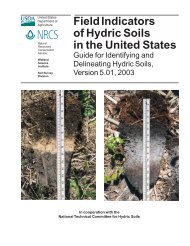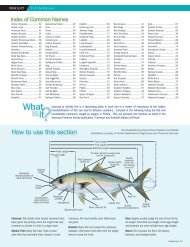Peace and Myakka River Water Quality Summary 2002 - Southwest ...
Peace and Myakka River Water Quality Summary 2002 - Southwest ...
Peace and Myakka River Water Quality Summary 2002 - Southwest ...
Create successful ePaper yourself
Turn your PDF publications into a flip-book with our unique Google optimized e-Paper software.
are transported from fresh to more saline waters. In estuaries, flocculation of humicacid colloids reportedly occurs preferentially at salinities between 0 <strong>and</strong> 5 ppt.Median color values for Florida rivers <strong>and</strong> estuaries, as reported by Friedemann <strong>and</strong>H<strong>and</strong> (1989) based on a survey of several thous<strong>and</strong> records retrieved from the U.S.EPA STORET database, are 70.0 <strong>and</strong> 20.0 pcu, respectively. Values observed in thetidal reaches of the <strong>Peace</strong> <strong>and</strong> <strong>Myakka</strong> river systems during water years 1994-2000were substantially higher than these statewide medians.Dissolved OxygenAnnual median dissolved oxygen concentrations varied over a relatively narrow range,between about 5.7 <strong>and</strong> 7.7 mg/L. Concentrations in the “stressful” (< 4 mg/L) rangewere recorded at least once during most years at every site. Concentrations in the“hypoxic” (< 2 mg/L) range, which are potentially fatal to organisms that cannot move toareas of higher oxygen availability, were observed at the following stations:• CH-02B (water years 1995, 1999, 2000)• CH-004 (all years)• CH-05B (1994, 1995, 1998, 1999)• CH-005 (all years)Chlorophyll-aChlorophyll-a concentrations, which provide estimates of phytoplankton biomass in thewater column, are helpful indicators of a waterbody’s trophic state. Annual medianconcentrations ranged between1.0 µg/L <strong>and</strong> 13 µg/L at the tidal <strong>Myakka</strong> <strong>River</strong> stations<strong>and</strong> between 2.3 <strong>and</strong> 10.6 µg/L in the tidal <strong>Peace</strong> <strong>River</strong>. The statewide medianchlorophyll-a concentration for Florida estuaries, as reported by an FDEP surveyconducted in the mid-1980’s, is 8.5 µg/L.Algal blooms (indicated by chlorophyll-a concentrations > 20 µg/L) occurred at every<strong>Peace</strong> <strong>and</strong> <strong>Myakka</strong> <strong>River</strong> station at some time during the monitoring period.Pronounced blooms, with chlorophyll concentrations > 50 µg/L, were observed at threesites.Annual mean chlorophyll-a concentrations observed at several stations during wateryears 1994-2000 exceeded 11 µg/L, a value that has been adopted by the State ofFlorida as indicating potentially impaired water quality conditions in the State’s estuarinewaters. Stations <strong>and</strong> years where the annual mean exceeded the 11 µg/L ‘impairment’level included:• <strong>Myakka</strong> <strong>River</strong> site CH-002 (water years 1995, 1999)• <strong>Myakka</strong> <strong>River</strong> site CH-02B (1995, 1998, 1999)• <strong>Peace</strong> <strong>River</strong> site CH-029 (1995, 1996)• <strong>Peace</strong> <strong>River</strong> site CH-004 (1994, 1995, 1996, 1999)• <strong>Peace</strong> <strong>River</strong> site CH-05B (1999)• <strong>Peace</strong> <strong>River</strong> site CH-005 (1994).xi



